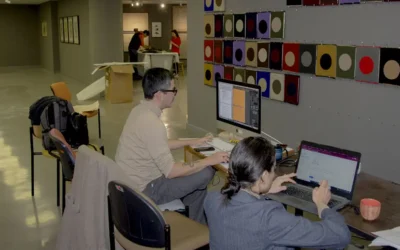Museum Forecast 2022

Rachael Cristine Woody
Forecasting is risky at the best of times as there’s no way to control every variable, and these last two years have offered an education in making plans. However, there’s value in going through the exercise of using current knowledge and observation of trends to map out different scenarios—as AAM’s Center for the Future of Museums does with the annual TrendsWatch reports.
As I enter my third year of offering official forecasts for the field, I want to share an observation with you. The issues or areas of focus we’ve included are items that I think we’ll be grappling with for the next 10 years. Some of these items have been long simmering issues, such as labor ethics. Others may have seemed temporary or “fads” to begin with, but the pandemic has served to deepen these issues—adding multiple dimensions.
As a recap, here are the first two official years of forecast areas:
- Museums Will Close
- Collections Accessioning and Deaccessioning
- Digital Collections are a Higher Priority
- DEAI embedded into museums and driving programmatic change
- Grant Funding, modest budgets, funding threatened, and incredibly competitive
- Ethical Labor Practices requiring salary transparency, institutions lack financial health
As I look to 2022, here are the three main items I foresee to be major points of reckoning in the museum field:
No More Half-Measures When It Comes to Offering Accessibility
Prior to the pandemic, the museum field was pretty awful at offering true accessibility to both employees as well as patrons. For example, in 2014 AAM created a Diversity and Inclusion Policy, and formed a DEAI Working Group in 2017, but lack of accessibility both at conferences and within the museums themselves was a topic that still had to be raised by our disabled colleagues while at AAM’s 2019 conference. And it’s not just AAM. This reluctance (intentional or not) to actually include “Accessibility” as a core issue for diversity and inclusion is wide-spread, no matter the industry. In my opinion, what it boils down to is the ease with which we can point to expense as the reason better accessibility can’t be provided. True. Creativity, methods, and tools for creating better access often cost money. But the issue isn’t the money. It’s the museum field’s inability to center “Accessibility” as a priority area that impacts both our colleagues and our patrons. The pandemic has served to prove just how quickly we can find the money for tools to facilitate our work and provide better accessibility for everyone. Regardless of what happens with the pandemic, we must continue to invest in accessibility first.
My forecast is that as a “return to normal” is increasingly pursued (in proportion with the threat-level of COVID-19 going down), it will also be met with an increase in resistance. A “return to normal” for our “Accessibility” practices would be a tragic step backward. The pandemic actually made our offerings more accessible. If the museum field fails to realize this, there is going to be significant backlash. As a dual-forecast, I think this area is also ripe with opportunities for innovation. I think we’ll see some amazing work and tools become available in the field that will make everyone’s work and museum experience better.
The Continued and Accelerated Elimination of Museum “Entry-Level” Jobs
The availability was already bad for *true* entry-level jobs prior to the pandemic. It’s such a common occurrence to see museum “entry-level” job posts that require a few years of experience (in addition to advanced degrees), that there are several new professionals’ Facebook groups that function as ad-hoc unemployment support groups. The pandemic has exacerbated the rarity of museum jobs and I’ve observed that the limited supply of entry-level jobs are being transitioned to “temporary”, “term”, or “project-based” positions.
My forecast is that this year will continue to be rough regarding the availability of true entry-level museum positions. But, we will also continue to see colleagues step up to demand the adoption of more ethical labor practices. In addition to salary transparency becoming required, I hope to see a similar effort of vetting job posts for entry-level positions to ensure they are truly available to those who are entry-level. And similar with the temporary or term jobs so as to ensure the jobs meet the criteria for term/temporary. By creating better policies and advocating for these changes at each of our museums, we can encourage the spread of ethical employment practices in the field.
Please see these posts for more information and resources on this issue: When and How to Ethically Create Museum Term Positions and LAMs are More Alike Than Different: Precarious Labor.
A Digital Boom
The prioritization and investment in digital collections is another area that has experienced some benefit from the pandemic.
My forecast is that the elongation of the pandemic into 2022 will grant a larger and larger space for innovation, interest in, and money for museum digital projects. I’m already seeing this increase in resources in the grant opportunities slated for 2022. We are at the intersection of interest, ability, and financial resources and it will lead to a digital boom for the field. We’re going to witness an evolution in how we provide engaging collection content online. There will be better tools available to craft exciting innovations in this area. And I, for one, cannot wait.
Conclusion
The truth is, museums who prioritize truly accessible work and collection engagement opportunities, who are ethical in their job creation, and who have the resources they need to pursue truly exciting digital projects are the museum which are going to thrive. Committing to being better in each of these areas will require practice, but if we are persistent, I believe we can evolve the museum field to a truly wondrous place.

Rachael Cristine Woody
Expert Rachael Cristine Woody advises on museum strategies, collections management, and grant writing for a wide variety of clients. In addition to several titles published by Lucidea Press, Ms. Woody is a regular contributor to the Think Clearly blog and a popular presenter. She also partnered with Lucidea to develop a free grants directory and database; use it along with a free grants workbook to familiarize yourself with grant strategy and use the four grant project templates provided.
Similar Posts
How to Incorporate Interns in Museum CMS Projects: Data Creation
A museum expert details how interns can be successfully included in museum CMS projects at the data creation stage.
How to Incorporate Interns in Museum CMS Projects: Data Capture
A museum expert highlights how interns can be included in museum CMS projects at the data capture stage
How to Incorporate Interns in Museum CMS Projects
A museum expert highlights how interns can be included in museum CMS projects with three project ideas.
Create a Start-to-Finish Process for Cataloging Objects in the Museum CMS
A museum expert outlines the start-to-finish process for cataloging objects into a new museum CMS.
Hosting service
Enjoy all of the benefits of your Lucidea solution with secure, reliable, stress free hosting
Programs & incentives
No matter your size or budget, we’ve got you covered, today and tomorrow




Leave a Comment
Comments are reviewed and must adhere to our comments policy.
0 Comments